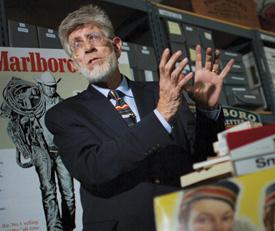Still Fuming
By Katherine Jamieson
 Alan Blum ’69
|
In 1990, when Dr. Alan Blum ’69 was last profiled in the magazine, a 10-story, neon-lit Joe Camel billboard, complete with ersatz cigarette packages, hovered over Times Square; it was the largest advertisement in the world. Though Joe came down in 1994, Blum, an anti-smoking crusader, is firm in his belief that the tobacco industry is as powerful—and nefarious—as ever.
“The taxi cab, subway and bus ads are gone, but the industry hasn’t gone away,” he says. Tobacco companies now market smokeless nicotine products—like candies and electronic cigarettes—that Blum believes are hardly harmless: they simply sustain nicotine addiction during social situations when it’s not acceptable to smoke. Tobacco companies may no longer advertise on TV, but they now use the Internet, as well as the U.S. Postal Service, to reach their consumers. “I get a Marlboro birthday card every year,” Blum says.
A family medicine physician who runs the University of Alabama Center for the Study of Tobacco and Society, Blum has been tobacco’s witness, chronicler and archivist for more than half a century. His “scholarly activist” approach had him organizing street demonstrations by day and writing articles for medical journals at night.
Since the 1990s, when the Tobacco Master Settlement Agreement forced cigarette companies to stop advertising to kids and to give money to states to defray smoking-related health-care costs, Blum has been watching, with a jaundiced eye, the wane of grassroots activism in the anti-smoking movement. Now that every state has a tobacco control office, he says, fewer physicians and citizens are fighting the fight: they believe government is on the case. According to the Centers for Disease Control, 46 percent of American adults smoked in 1964, compared to 20 percent today—but because of population growth, the decline in the absolute number of smokers is less dramatic than those percentages make it seem. “It’s the biggest health failure of the 20th century,” Blum contends.
Blum has compiled the world’s most extensive archive of original artifacts and ephemera from the tobacco industry and the anti-smoking movement—a collection he began as a teenager. The Blum Archive includes thousands of items—news stories, company reports, cartoons, advertisements (“As your dentist, I would recommend Viceroys”). The activist-physician is now seeking a home for his collection, but the cost of preserving and storing it is prohibitive for many libraries. Still, he soldiers on, quoting (from a TV report he once saw) a 92-year-old activist’s secret to a long life: “I stay pissed off.”
Photo by Rob Mattson